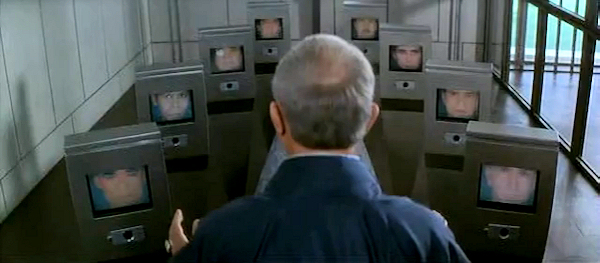[From Bob Enderle’s Unfiltered Opinion IT Business Edge blog]
[Image: A scene from the film Demolition Man]
Facebook and the Ugly Present, Wonderful Future of Video Communications
Posted by Rob Enderle Jul 7, 2011
One-on-one videoconferencing has likely had the longest time coming to market of any tech product since it became viable as a technology. First showcased in the 1960s, I participated in the first large trials at Apple that started in the late 1980s. While desktop cameras proliferated on notebooks and as USB peripherals, for much of the last two decades, people have rarely performed video calls.
WebEx and Microsoft’s Live Meeting have had video capability for several years now and Skype has had it far longer, yet folks just don’t choose to use these features. Large-room videoconferencing has been under deployment for nearly two decades and it is currently backed by Cisco, but HP recently exited the business selling it to Polycom, which has acquired a massive number of similar companies over the last couple of decades to become the equivalent of the great videoconferencing graveyard.
Conference-room solutions are expensive but, if used properly, can pay for themselves in months in terms of saved travel expense, and yet they are still rarely used. Desktop videoconferencing systems have been around for over a decade and are both cheap and relatively easy to use. If we really like to communicate by seeing people, why hasn’t desktop videoconferencing taken off yet?
Let’s explore why video isn’t really working right now and touch on what’s coming that may change this. The trigger is the Facebook Video Chat announcement, which makes the mistake of the past but has the potential to evolve into something that actually is amazing.
Flawed Assumptions
Over the years, it has been clear that these systems are surrounded by a series of flawed assumptions around how people like to communicate.
Flawed Assumption #1: People like to look folks in the eye. Watch how you talk to people normally. Do you really stare into their eyes, or are you watching their body language or sharing a view with them? I think you’ll find that unless you are confronting them or in a romantic situation, you aren’t looking folks in the eyes. In a conference room presentation, the presenter is typically standing with the flip chart, foils or slides displayed to one side of them. The total presentation is the speaker and the slides in one view.
Desktop videoconferencing systems like those that will be used by Facebook Video Chat put you eye-to-eye with the person you are talking to. Because this positioning is more confrontational, it tends also to be more uncomfortable. Room videoconferencing systems put the audiences across a virtual table from each other and the presentation on another screen or instead of looking at the speaker. This actually creates more in-session contention or switches the experience to more of a remote PowerPoint viewing, which increases confrontation and lowers the effectiveness of the meeting or eliminates the picture of the speaker all together.
Flawed Assumption #2: The most important thing to see is the remote audience. Individually, if you are chatting you are likely chatting about something other than yourself. Hopefully, you are rarely chatting about each other’s eyes and facial defects. Yet that is where the camera is focused. If you watch a news show, yes they show the reporters, but they typically switch to the subject they are talking about or show it behind them.
If you are talking to an individual you are typically showing pictures, sharing a TV show and most always are talking about something else. Yet trying to do a video call and share stuff in the same window is still nearly impossible to do. At least with the Facebook solution you can chat about what is in the background on Facebook, but I expect that is not going to be the topic of conversation the majority of the time.
Flawed Assumption #3: Being in a group meeting or an individual meeting is mutually exclusive. This assumption seems to suggest that meetings and conversations don’t change. Now individually that is largely true, but group meetings often break down into individual conversations at break, over lunch or at a variety of venues after the event.
Wrapping Up: The Future of Telepresence/Teleconferencing/Video Chat
The movie “Demolition Man” had a prototype telepresence conference room that was never deployed but likely represented a better approach than those currently in market. Note how the speaker can move and the perspective of the audience can move with them.
There is some effort to use robotic proxies — robotic telepresence — to address this mobile change. Granted, these are kind of rough now but seem to be rapidly gaining favor as a better alternative than those currently in market.
Interesting enough, while the initial Facebook Video Chat seems to repeat the mistakes of the past, Facebook itself contains a lot of the information people are talking about. It has the capability to develop a richer service where there is a blend of a video image of the speaker and a second display controlled by both to share pictures, websites, written conversations or even live video of what folks are actually seeing. For instance, what if you fired up both cameras on a tablet and not only saw the person talking, but what the person was seeing and created a saved video file of any combination of this the user wanted that could be shared with other friends? This could actually evolve into something far more successful.
In the end, it looks like folks are getting really close to creating the successful video communications product. I’m convinced we have all of the pieces. We just have to wait for someone to put them together in a winning fashion.
